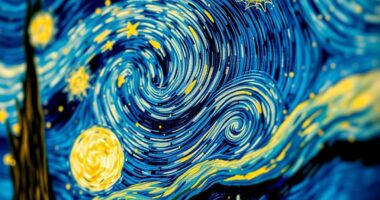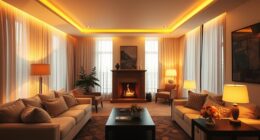You’re exploring how neon art has grown from classic glass-lit signs to innovative displays. Traditionally, it used gas-filled tubes shaped into vibrant designs, but now LED technology offers safer, more flexible options that mimic neon’s glow. Modern artists use programmable LEDs for dynamic, eye-catching effects, making neon art more accessible and eco-friendly. If you keep exploring, you’ll discover even more fascinating techniques behind this luminous evolution.
Key Takeaways
- Neon art originated with traditional gas-filled glass tubes, popularized in the early 20th century for signage and artistic displays.
- Techniques involve bending and shaping glass tubes filled with neon or other gases to create luminous designs.
- Modern LED alternatives mimic neon’s glow, offering safer, more flexible methods for creating neon-style artworks.
- The rise of LED technology has expanded neon art’s accessibility, enabling dynamic, colorful, and interactive installations.
- Current trends blend traditional neon craftsmanship with innovative LED techniques, pushing creative boundaries in contemporary art.

Have you ever wondered how vibrant, glowing signs and artworks come to life? The answer lies in the fascinating world of neon art, where luminous displays captivate and inspire. While traditional neon lighting relies on gas-filled tubes, today’s artists and designers often explore LED alternatives to achieve similar glowing effects. These modern options not only replicate the visual appeal of classic neon but also bring several practical advantages. LEDs consume less energy, last longer, and are safer to handle, making them popular choices for contemporary applications. From commercial signage to immersive art installations, LED technology opens new avenues for creativity without the fragility and high maintenance costs associated with traditional neon.
Neon art now uses LED technology for energy efficiency, safety, and creative flexibility.
In modern applications, neon art has evolved far beyond its origins. Today, it’s not just about creating bright signs but also about pushing artistic boundaries. Artists use neon-inspired LED lights to craft intricate sculptures, dynamic murals, and interactive displays. This shift allows for more flexible designs, as LED lights are easily programmable, enabling color changes and animations that were impossible with traditional glass tubes. You might see LED neon signs lighting up trendy cafes or vibrant city streets, transforming ordinary spaces into lively hubs of expression. These alternatives are also more environmentally friendly, aligning with growing concerns about sustainability in art and design. As a result, neon-inspired LED applications are becoming a staple in modern architecture, interior design, and public art projects.
Moreover, the ease of installation and maintenance makes LED alternatives appealing for various settings. Unlike traditional neon, which requires specialized skills to bend glass and fill tubes with gases, LED neon strips or flex lights are straightforward to install. You simply cut and shape them to fit your design, then connect them to a power source. This simplicity means you can experiment more freely, adjusting your artwork or signage with ease. It also means that small businesses, startups, and even DIY enthusiasts can incorporate neon aesthetics into their projects without a hefty budget or technical expertise. This democratization of neon art has led to a surge in innovative applications, from personalized home decor to large-scale public art installations.
Ultimately, the rise of LED alternatives in neon art signifies a blend of tradition and innovation. While the iconic glow of classic neon remains a symbol of retro charm, modern applications leverage advancements in LED technology to expand what’s possible. Whether you’re an artist, designer, or simply someone who appreciates striking visuals, understanding these alternatives helps you see how neon’s luminous legacy continues to evolve—brightening spaces with energy-efficient, versatile, and stunning displays. Additionally, the development of high-quality color fidelity in LED neon lights further enhances their ability to replicate the vivid hues of traditional neon, making them even more appealing for artistic and commercial use.
Frequently Asked Questions
How Do Neon Artists Choose Their Color Palettes?
You choose your neon color palettes based on color psychology and cultural symbolism. Think about how colors evoke emotions or convey specific meanings—red for passion, blue for calm, yellow for energy. You also consider cultural symbolism, like how certain colors hold particular significance in different societies. By blending these insights, you select vibrant hues that create the desired mood and message in your neon art piece.
What Safety Precautions Are Needed When Working With Neon Gases?
When handling neon gases, you need to prioritize safety gear like gloves, goggles, and proper clothing to protect yourself from potential exposure. Always handle gases in well-ventilated areas and use appropriate gas handling equipment to prevent leaks or accidents. Follow strict safety protocols, including checking for leaks and ensuring proper ventilation, to minimize risks. Staying cautious and prepared helps you work safely with neon gases.
How Has Digital Technology Influenced Modern Neon Art?
Digital technology has revolutionized modern neon art by integrating LED lights, which allow for dynamic, energy-efficient displays. You can now incorporate virtual reality, creating immersive experiences that push the boundaries of traditional neon work. This fusion enables artists to experiment with interactive installations, blending physical neon elements with digital enhancements. As a result, your art becomes more engaging and versatile, appealing to a broader audience and opening new creative possibilities.
Can Neon Art Be Recycled or Reused?
Imagine neon tubes as glowing bridges that can reconnect with new life; yes, you can recycle neon tubes and reuse neon components. Skilled artisans carefully disassemble and refurbish these luminous pathways, transforming them into fresh art pieces or functional signage. This process keeps the vibrant glow alive, reducing waste while honoring the beauty of neon’s craftsmanship. Reusing neon parts not only sustains the art but also preserves its luminous legacy.
What Are the Costs Associated With Creating Neon Artwork?
The costs of creating neon artwork can vary based on material expenses and your project’s complexity. You should consider cost estimation for materials like glass tubes, neon gas, and electrical components. Custom designs, size, and artist fees also influence the overall price. Expect to spend a few hundred to several thousand dollars, depending on your scope. Planning your budget carefully will help guarantee your neon art project stays within your financial limits.
Conclusion
As you explore neon art, you see its history and technique intertwine, shaping vibrant expressions that captivate your senses. You witness the evolution from simple signs to stunning masterpieces, appreciating the skill behind each glow. You feel inspired by the artistry and innovation fueling this medium. Neon art invites you to celebrate creativity, embrace transformation, and enjoy the luminous beauty that continues to light up our world. It’s a story of passion, progress, and endless possibility.








